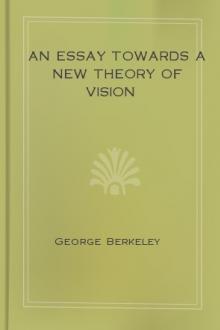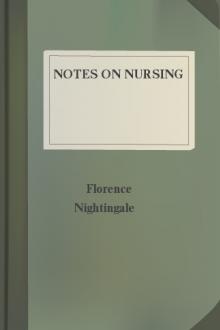An Essay Towards a New Theory of Vision by George Berkeley (the little red hen ebook txt) 📖

- Author: George Berkeley
- Performer: -
Book online «An Essay Towards a New Theory of Vision by George Berkeley (the little red hen ebook txt) 📖». Author George Berkeley
110. Hence it follows that a man born blind and afterwards, when grown up, made to see, would not in the first act of vision parcel out the ideas of sight into the same distinct collections that others do, who have experienced which do regularly coexist and are proper to be bundled up together under one name. He would not, for example, make into one complex idea, and thereby esteem an unit, all those particular ideas which constitute the visible head or foot. For there can be no reason assigned why he should do so, barely upon his seeing a man stand upright before him. There crowd into his mind the ideas which compose the visible man, in company with all the other ideas of sight perceived at the same time: but all these ideas offered at once to his view, he would not distribute into sundry distinct combinations till such time as by observing the motion of the parts of the man and other experiences he comes to know which are to be separated and which to be collected together.
111. From what hath been premised it is plain the objects of sight and touch make, if I may so say, two sets of ideas which are widely different from each other. To objects of either kind we indifferently attribute the terms high and low, right and left, and suchlike, denoting the position or situation of things: but then we must well observe that the position of any object is determined with respect only to objects of the same sense. We say any object of touch is high or low, according as it is more or less distant from the tangible earth: and in like manner we denominate any object of sight high or low in proportion as it is more or less distant from the visible earth: but to define the situation of visible things with relation to the distance they bear from any tangible thing, or VICE VERSA, this were absurd and perfectly unintelligible. For all visible things are equally in the mind, and take up no part of the external space: and consequently are equidistant from any tangible thing which exists without the mind.
112. Or rather, to speak truly, the proper objects of sight are at no distance, neither near nor far, from any tangible thing. For if we inquire narrowly into the matter we shall find that those things only are compared together in respect of distance which exist after the same manner, or appertain unto the same sense. For by the distance between any two points nothing more is meant than the number of intermediate points: if the given points are visible the distance between them is marked out by the number of the interjacent visible points: if they are tangible, the distance between them is a line consisting of tangible points; but if they are one tangible and the other visible, the distance between them doth neither consist of points perceivable by sight nor by touch, i.e. it is utterly inconceivable. This, perhaps, will not find an easy admission into all men’s understanding: however, I should gladly be informed whether it be not true by anyone who will be at the pains to reflect a little and apply it home to his thoughts.
113. The not observing what has been delivered in the two last sections seems to have occasioned no small part of the difficulty that occurs in the business of erect appearances. The head, which is painted nearest the earth, seems to be farthest from it: and on the other hand the feet, which are painted farthest from the earth, are thought nearest to it.
Herein lies the difficulty, which vanishes if we express the thing more clearly and free from ambiguity, thus: how comes it that to the eye the visible head which is nearest the tangible earth seems farthest from the earth, and the visible feet, which are farthest from the tangible earth seem nearest the earth? The question being thus proposed, who sees not the difficulty is founded on a supposition that the eye, or visive faculty, or rather the soul by means thereof, should judge of the situation of visible objects with reference to their distance from the tangible earth? Whereas it is evident the tangible earth is not perceived by sight: and it hath been shown in the two last preceding sections that the location of visible objects is determined only by the distance they bear from one another; and that it is nonsense to talk of distance, far or near, between a visible and tangible thing.
114. If we confine our thoughts to the proper objects of sight, the whole is plain and easy. The head is painted farthest from, and the feet nearest to, the visible earth; and so they appear to be. What is there strange or unaccountable in this? Let us suppose the pictures in the fund of the eye to be the immediate objects of the sight. The consequence is that things should appear in the same posture they are painted in; and is it not so? The head which is seen seems farthest from the earth which is seen; and the feet which are seen seem nearest to the earth, which is seen; and just so they are painted.
115. But, say you, the picture of the man is inverted, and yet the appearance is erect: I ask, what mean you by the picture of the man, or, which is the same thing, the visible man’s being inverted? You tell me it is inverted, because the heels are uppermost and the head undermost?
Explain me this. You say that by the head’s being undermost you mean that it is nearest to the earth; and by the heels being uppermost that they are farthest from the earth. I ask again what earth you mean? You cannot mean the earth that is painted on the eye, or the visible earth: for the picture of the head is farthest from the picture of the earth, and the picture of the feet nearest to the picture of the earth; and accordingly the visible head is farthest from the visible earth, and the visible feet nearest to it. It remains, therefore, that you mean the tangible earth, and so determine the situation of visible things with respect to tangible things; contrary to what hath been demonstrated in sect. 111 and 112. The two distinct provinces of sight and touch should be considered apart, and as if their objects had no intercourse, no manner of relation one to another, in point of distance or position.
116. Farther, what greatly contributes to make us mistake in this matter is that when we think of the pictures in the fund of the eye, we imagine ourselves looking on the fund of another’s eye, or another looking on the fund of our own eye, and beholding the pictures painted thereon. Suppose two eyes A and B: A from some distance looking on the pictures in B sees them inverted, and for that reason concludes they are inverted in B: but this is wrong. There are projected in little on the bottom of A the images of the pictures of, suppose, man, earth, etc., which are painted on B. And besides these the eye B itself, and the objects which environ it, together with another earth, are projected in a larger size on A.
Now, by the eye A these larger images are deemed the true objects, and the lesser only pictures in miniature. And it is with respect to those greater images that it determines the situation of the smaller images: so that comparing the little man with the great earth, A judges him inverted, or that the feet are farthest from and the head nearest to the great earth. Whereas, if A compare the little man with the little earth, then he will appear erect, i.e. his head shall seem farthest from, and his feet nearest to, the little earth. But we must consider that B does not see two earths as A does: it sees only what is represented by the little pictures in A, and consequently shall judge the man erect. For, in truth, the man in B is not inverted, for there the feet are next the earth; but it is the representation of it in A which is inverted, for there the head of the representation of the picture of the man in B is next the earth, and the feet farthest from the earth, meaning the earth which is without the representation of the pictures in B. For if you take the little images of the pictures in B, and consider them by themselves, and with respect only to one another, they are all erect and in their natural posture.
117. Farther, there lies a mistake in our imagining that the pictures of external objects are painted on the bottom of the eye. It hath been shown there is no resemblance BETWEEN the ideas of sight and things tangible.
It hath likewise been demonstrated that the proper objects of sight do not exist without the mind. Whence it clearly follows that the pictures painted on the bottom of the eye are not the pictures of external objects. Let anyone consult his own thoughts, and then say what affinity, what likeness there is between that certain variety and disposition of colours which constitute the visible man, or picture of a man, and that other combination of far different ideas, sensible by touch, which compose the tangible man. But if this be the case, how come they to be accounted pictures or images, since that supposes them to copy or represent some originals or other?
118. To which I answer: in the forementioned instance the eye A takes the little images, included within the representation of the other eye B, to be pictures or copies, whereof the archetypes are not things existing without, but the larger pictures projected on its own fund: and which by A are not thought pictures, but the originals, or true things themselves.
Though if we suppose a third eye C from a due distance to behold the fund of A, then indeed the things projected thereon shall, to C, seem pictures or images in the same sense that those projected on B do to A.
119. Rightly to conceive this point we must carefully distinguish between the ideas of sight and touch, between the visible and tangible eye; for certainly on the tangible eye nothing either is or seems to be painted.
Again, the visible eye, as well as all other visible objects, hath been shown to exist only in the mind, which perceiving its own ideas, and comparing them together, calls some PICTURES in respect of others. What hath been said, being rightly comprehended and laid together, doth, I think, afford a full and genuine explication of the erect appearance of objects; which phenomenon, I must confess, I do not see how it can be explained by any theories of vision hitherto made public.
120. In treating of these things the use of language is apt to occasion some obscurity and confusion, and create in us wrong ideas; for language being accommodated to the common notions and prejudices of men, it is
 A very interesting statement of one of our contemporaries is that any person, to one degree or another, is both a psychologist and a philosopher - they say, life forces him to. On the one hand, the main driving force of every person is the craving for knowledge, the desire to reach certain social heights, the desire to be wise in any everyday situations - and this is the philosophy of life.
A very interesting statement of one of our contemporaries is that any person, to one degree or another, is both a psychologist and a philosopher - they say, life forces him to. On the one hand, the main driving force of every person is the craving for knowledge, the desire to reach certain social heights, the desire to be wise in any everyday situations - and this is the philosophy of life. 




Comments (0)